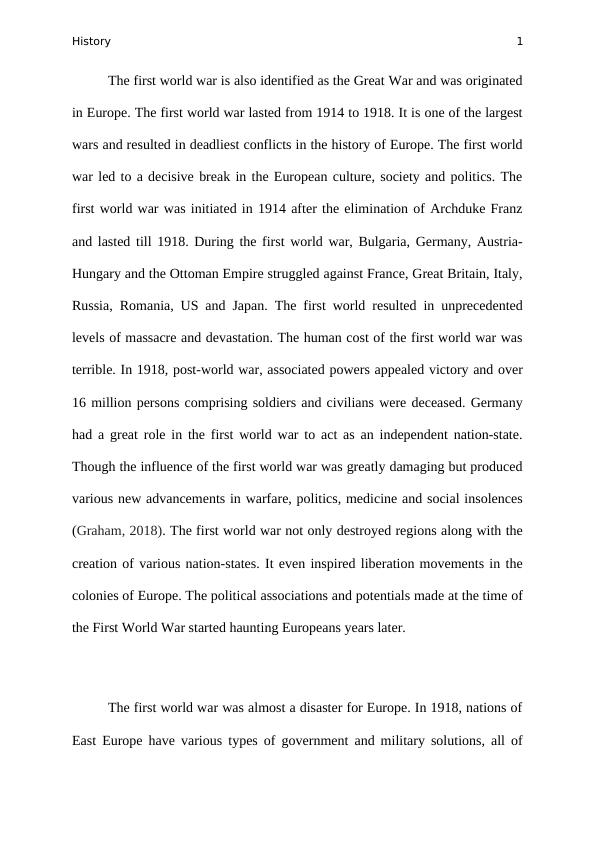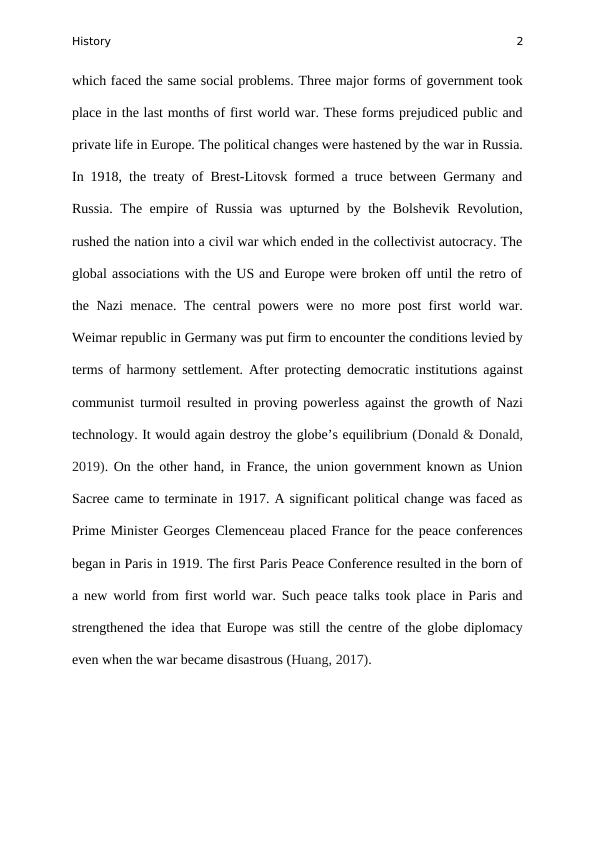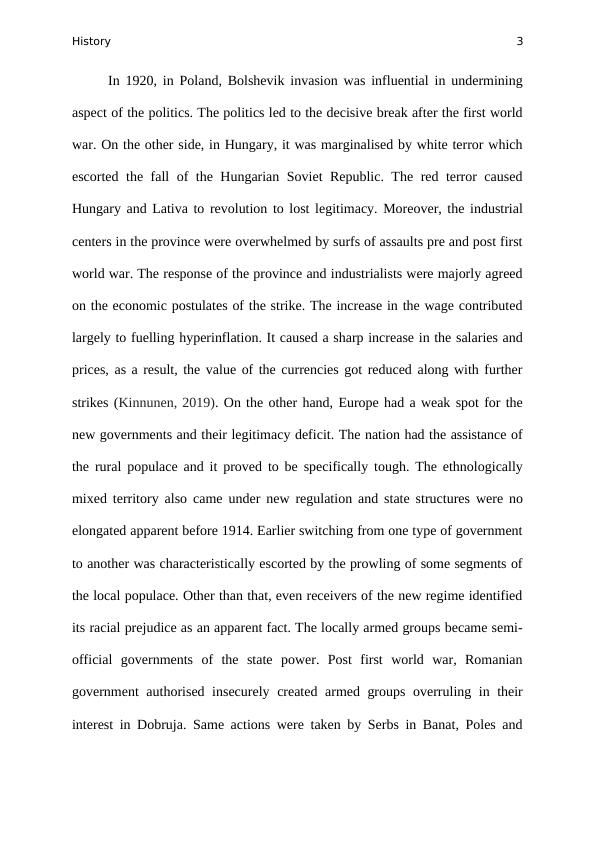History - The first world war in Europe
14 Pages3739 Words20 Views
Added on 2022-08-28
History - The first world war in Europe
Added on 2022-08-28
ShareRelated Documents
HISTORY

History 1
The first world war is also identified as the Great War and was originated
in Europe. The first world war lasted from 1914 to 1918. It is one of the largest
wars and resulted in deadliest conflicts in the history of Europe. The first world
war led to a decisive break in the European culture, society and politics. The
first world war was initiated in 1914 after the elimination of Archduke Franz
and lasted till 1918. During the first world war, Bulgaria, Germany, Austria-
Hungary and the Ottoman Empire struggled against France, Great Britain, Italy,
Russia, Romania, US and Japan. The first world resulted in unprecedented
levels of massacre and devastation. The human cost of the first world war was
terrible. In 1918, post-world war, associated powers appealed victory and over
16 million persons comprising soldiers and civilians were deceased. Germany
had a great role in the first world war to act as an independent nation-state.
Though the influence of the first world war was greatly damaging but produced
various new advancements in warfare, politics, medicine and social insolences
(Graham, 2018). The first world war not only destroyed regions along with the
creation of various nation-states. It even inspired liberation movements in the
colonies of Europe. The political associations and potentials made at the time of
the First World War started haunting Europeans years later.
The first world war was almost a disaster for Europe. In 1918, nations of
East Europe have various types of government and military solutions, all of
The first world war is also identified as the Great War and was originated
in Europe. The first world war lasted from 1914 to 1918. It is one of the largest
wars and resulted in deadliest conflicts in the history of Europe. The first world
war led to a decisive break in the European culture, society and politics. The
first world war was initiated in 1914 after the elimination of Archduke Franz
and lasted till 1918. During the first world war, Bulgaria, Germany, Austria-
Hungary and the Ottoman Empire struggled against France, Great Britain, Italy,
Russia, Romania, US and Japan. The first world resulted in unprecedented
levels of massacre and devastation. The human cost of the first world war was
terrible. In 1918, post-world war, associated powers appealed victory and over
16 million persons comprising soldiers and civilians were deceased. Germany
had a great role in the first world war to act as an independent nation-state.
Though the influence of the first world war was greatly damaging but produced
various new advancements in warfare, politics, medicine and social insolences
(Graham, 2018). The first world war not only destroyed regions along with the
creation of various nation-states. It even inspired liberation movements in the
colonies of Europe. The political associations and potentials made at the time of
the First World War started haunting Europeans years later.
The first world war was almost a disaster for Europe. In 1918, nations of
East Europe have various types of government and military solutions, all of

History 2
which faced the same social problems. Three major forms of government took
place in the last months of first world war. These forms prejudiced public and
private life in Europe. The political changes were hastened by the war in Russia.
In 1918, the treaty of Brest-Litovsk formed a truce between Germany and
Russia. The empire of Russia was upturned by the Bolshevik Revolution,
rushed the nation into a civil war which ended in the collectivist autocracy. The
global associations with the US and Europe were broken off until the retro of
the Nazi menace. The central powers were no more post first world war.
Weimar republic in Germany was put firm to encounter the conditions levied by
terms of harmony settlement. After protecting democratic institutions against
communist turmoil resulted in proving powerless against the growth of Nazi
technology. It would again destroy the globe’s equilibrium (Donald & Donald,
2019). On the other hand, in France, the union government known as Union
Sacree came to terminate in 1917. A significant political change was faced as
Prime Minister Georges Clemenceau placed France for the peace conferences
began in Paris in 1919. The first Paris Peace Conference resulted in the born of
a new world from first world war. Such peace talks took place in Paris and
strengthened the idea that Europe was still the centre of the globe diplomacy
even when the war became disastrous (Huang, 2017).
which faced the same social problems. Three major forms of government took
place in the last months of first world war. These forms prejudiced public and
private life in Europe. The political changes were hastened by the war in Russia.
In 1918, the treaty of Brest-Litovsk formed a truce between Germany and
Russia. The empire of Russia was upturned by the Bolshevik Revolution,
rushed the nation into a civil war which ended in the collectivist autocracy. The
global associations with the US and Europe were broken off until the retro of
the Nazi menace. The central powers were no more post first world war.
Weimar republic in Germany was put firm to encounter the conditions levied by
terms of harmony settlement. After protecting democratic institutions against
communist turmoil resulted in proving powerless against the growth of Nazi
technology. It would again destroy the globe’s equilibrium (Donald & Donald,
2019). On the other hand, in France, the union government known as Union
Sacree came to terminate in 1917. A significant political change was faced as
Prime Minister Georges Clemenceau placed France for the peace conferences
began in Paris in 1919. The first Paris Peace Conference resulted in the born of
a new world from first world war. Such peace talks took place in Paris and
strengthened the idea that Europe was still the centre of the globe diplomacy
even when the war became disastrous (Huang, 2017).

History 3
In 1920, in Poland, Bolshevik invasion was influential in undermining
aspect of the politics. The politics led to the decisive break after the first world
war. On the other side, in Hungary, it was marginalised by white terror which
escorted the fall of the Hungarian Soviet Republic. The red terror caused
Hungary and Lativa to revolution to lost legitimacy. Moreover, the industrial
centers in the province were overwhelmed by surfs of assaults pre and post first
world war. The response of the province and industrialists were majorly agreed
on the economic postulates of the strike. The increase in the wage contributed
largely to fuelling hyperinflation. It caused a sharp increase in the salaries and
prices, as a result, the value of the currencies got reduced along with further
strikes (Kinnunen, 2019). On the other hand, Europe had a weak spot for the
new governments and their legitimacy deficit. The nation had the assistance of
the rural populace and it proved to be specifically tough. The ethnologically
mixed territory also came under new regulation and state structures were no
elongated apparent before 1914. Earlier switching from one type of government
to another was characteristically escorted by the prowling of some segments of
the local populace. Other than that, even receivers of the new regime identified
its racial prejudice as an apparent fact. The locally armed groups became semi-
official governments of the state power. Post first world war, Romanian
government authorised insecurely created armed groups overruling in their
interest in Dobruja. Same actions were taken by Serbs in Banat, Poles and
In 1920, in Poland, Bolshevik invasion was influential in undermining
aspect of the politics. The politics led to the decisive break after the first world
war. On the other side, in Hungary, it was marginalised by white terror which
escorted the fall of the Hungarian Soviet Republic. The red terror caused
Hungary and Lativa to revolution to lost legitimacy. Moreover, the industrial
centers in the province were overwhelmed by surfs of assaults pre and post first
world war. The response of the province and industrialists were majorly agreed
on the economic postulates of the strike. The increase in the wage contributed
largely to fuelling hyperinflation. It caused a sharp increase in the salaries and
prices, as a result, the value of the currencies got reduced along with further
strikes (Kinnunen, 2019). On the other hand, Europe had a weak spot for the
new governments and their legitimacy deficit. The nation had the assistance of
the rural populace and it proved to be specifically tough. The ethnologically
mixed territory also came under new regulation and state structures were no
elongated apparent before 1914. Earlier switching from one type of government
to another was characteristically escorted by the prowling of some segments of
the local populace. Other than that, even receivers of the new regime identified
its racial prejudice as an apparent fact. The locally armed groups became semi-
official governments of the state power. Post first world war, Romanian
government authorised insecurely created armed groups overruling in their
interest in Dobruja. Same actions were taken by Serbs in Banat, Poles and

End of preview
Want to access all the pages? Upload your documents or become a member.
Related Documents
World War 1 & World War 2: Same War?lg...
|4
|1344
|77
Essay on First World Warlg...
|6
|1399
|258
Strengths and Weaknesses of United Nations Genocide Conventionlg...
|10
|2934
|458
The First World War in Europelg...
|6
|1302
|78
Causes and consequences of second world war PDFlg...
|11
|2451
|266
World War II: The Most Destructive Battles in the Worldlg...
|8
|2016
|18
